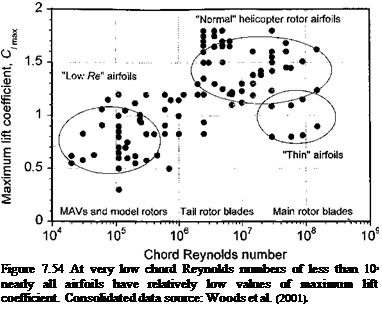Very Low Reynolds Number Airfoil Characteristics
There has been much recent interest in understanding rotating wing airfoil characteristics at very low Reynolds numbers because of the generally low performance of existing micro air vehicles or MAVs (see Muller (2001) and discussion by Bohorquez et al. (2003), and also Section 6.14). The flow over airfoils at Reynolds numbers of less than 105 are generally more complicated that those at higher Reynolds numbers because of stronger viscous effects, and as yet these effects are not well understood. The main problems include: 1. The susceptibility of a laminar boundary layer to separate under only mild adverse pressure gradients; 2. The formation of long laminar separation bubbles; 3. The thick boundary layers, high drag, and low maximum lift coefficients; and 4. The increased sensitivity of airfoil characteristics to surface condition and free-stream turbulence. Furthermore, at these low Reynolds numbers the airfoil characteristics tend to vary in a highly nonlinear manner with
respect to AoA, making modeling attempts much more challenging. It is in this regime that fundamental research in experimental fluid mechanics and modeling efforts using advanced numerical solutions to the Navier-Stokes equations are beginning to make an impact – see lvnuw ronnn
iTiuilvi J«
Besides the generally higher drag coefficients of airfoils that operate at low Reynolds numbers (see Fig. 7.4) this is accompanied by low maximum lift coefficients of 1.0 or less and low lift-to-drag ratios of 10 or less. This seriously impacts the overall flight performance of rotating-wing based MAVs – see Bohorquez et al. (2003) and Martin (2005). The results shown in Fig. 7.54 are consolidated data from many sources of low Reynolds number measurements that have been compiled by Woods et al. (2001) and show that values of C/max may be on average about half of the values found at higher Reynolds numbers, but perhaps with some exceptions. It would seem also that at these Reynolds numbers the aerodynamic performance of crude flat-plate types of airfoils are often surprisingly better that conventional airfoil profiles, raising many questions about what a low Reynolds number airfoil should really look like, especially for a rotor. The impact of higher airfoil drag coefficients and lower maximum lift coefficients generally translates into much lower values of rotor figure of merit; measured values of FM for rotating wing MAVs are typically in the range of 0.3 to 0.4 compared to values approaching 0.82 for a modem full-scale helicopter
![]()
 |
rotor (Fig. 6.2). However, the ability to generate maximum
1.5 on rotating wings at very low Reynolds numbers seems possible based on the studies of Azuma & Yasuda (1989). For further information on the aerodynamics of airfoils at very low Reynolds numbers; see AGARD (1985), RAeS (1986), and Muller (2001).











